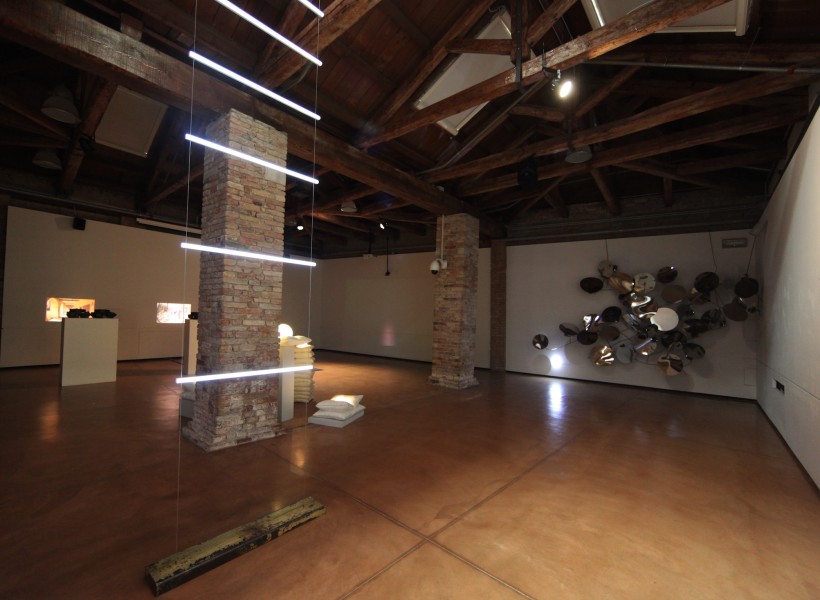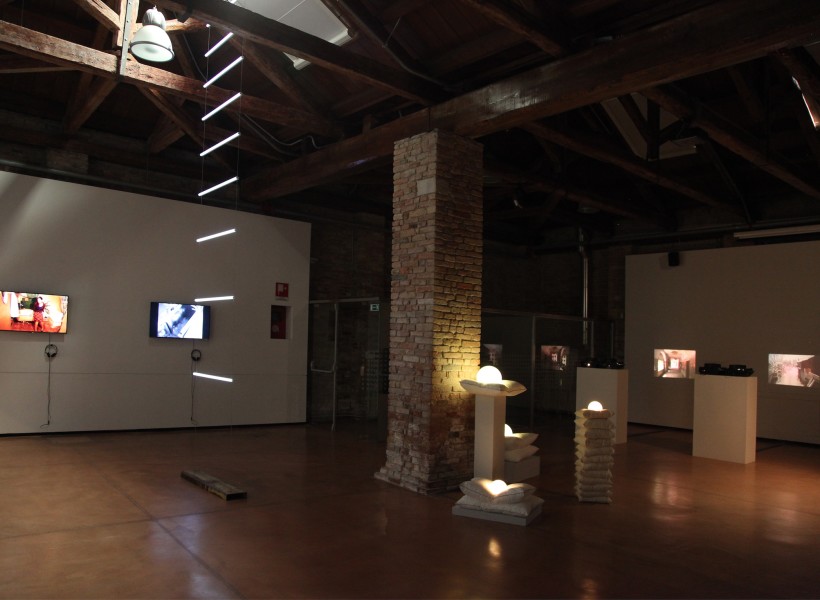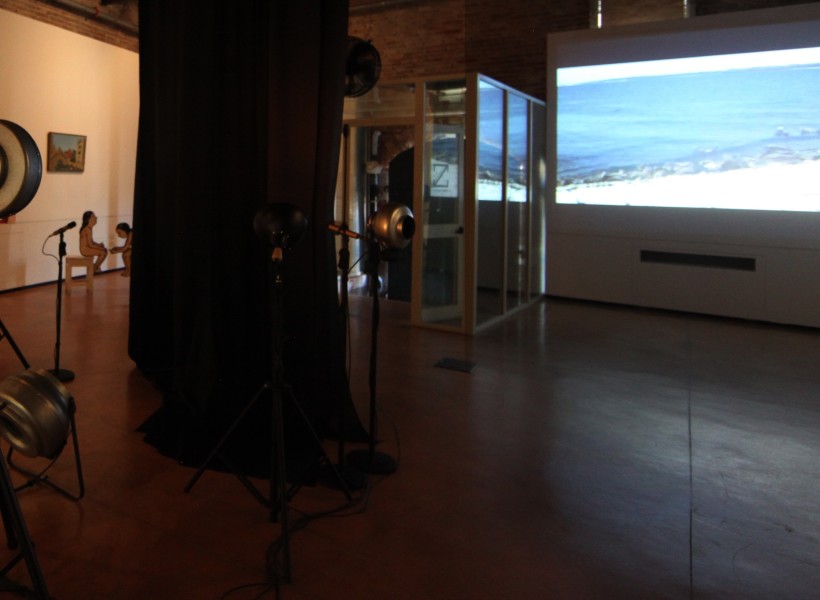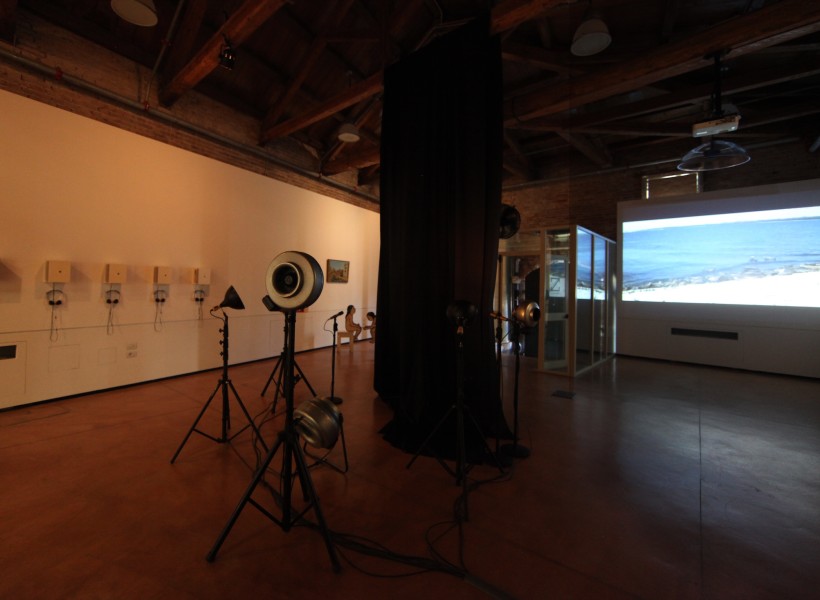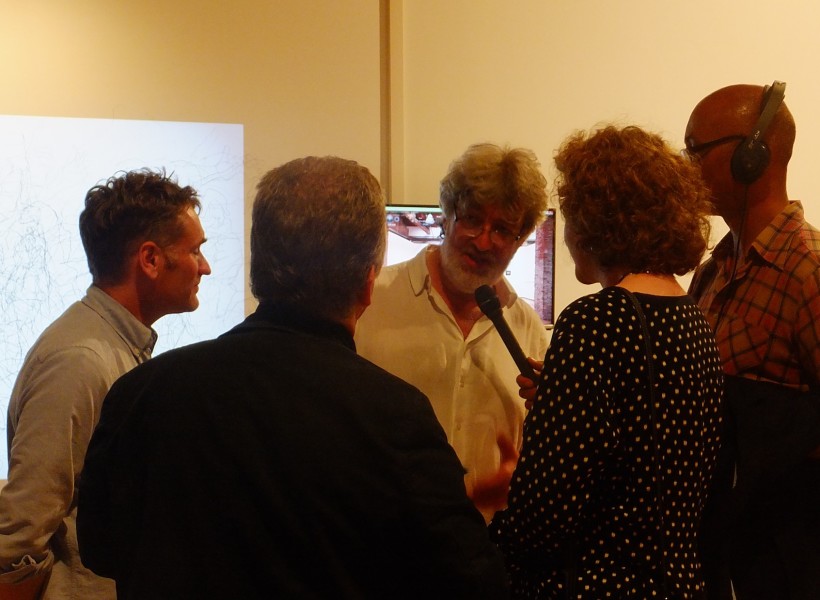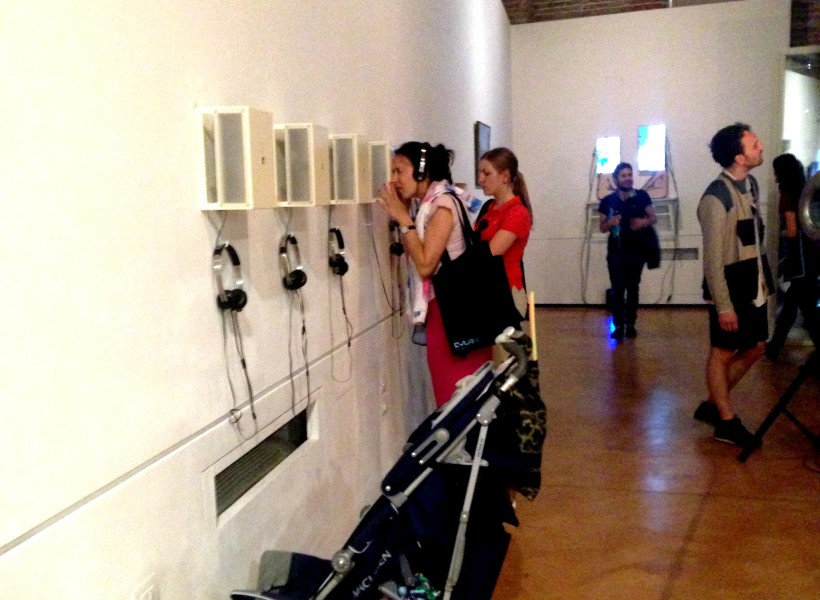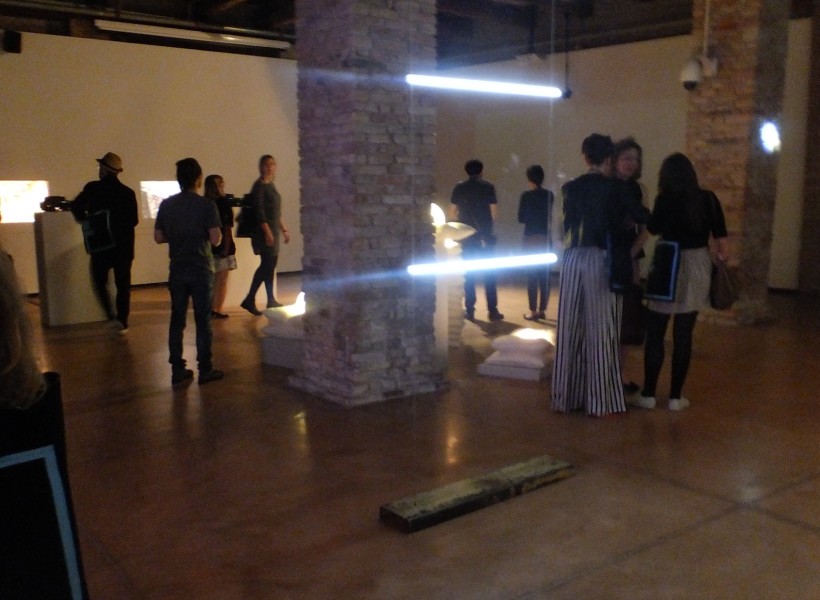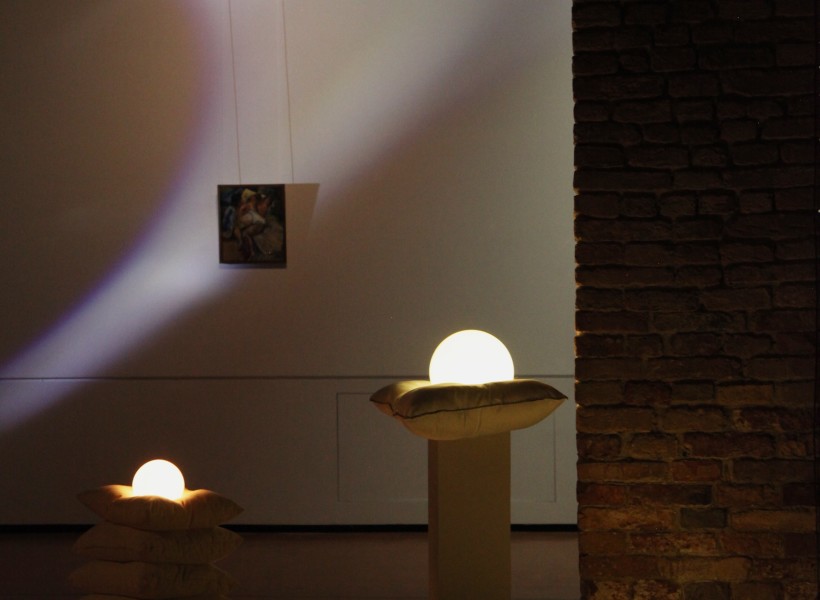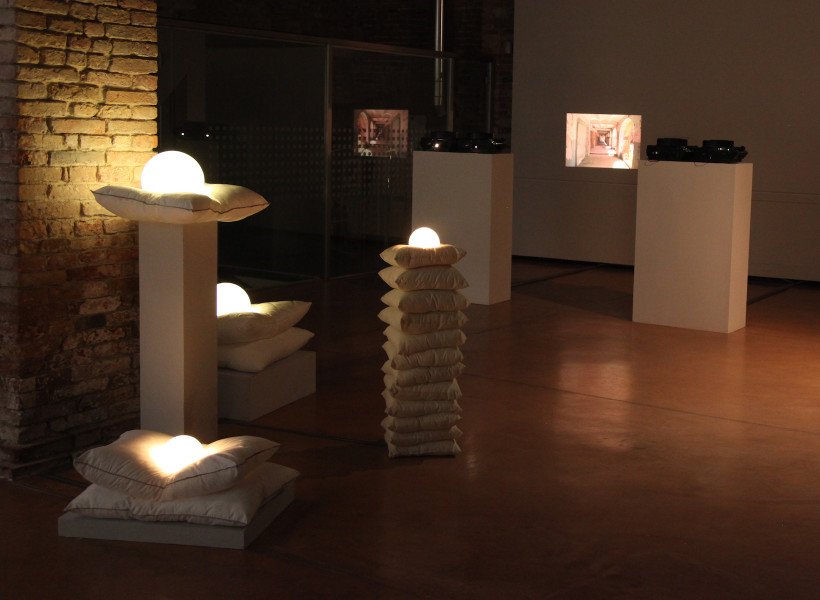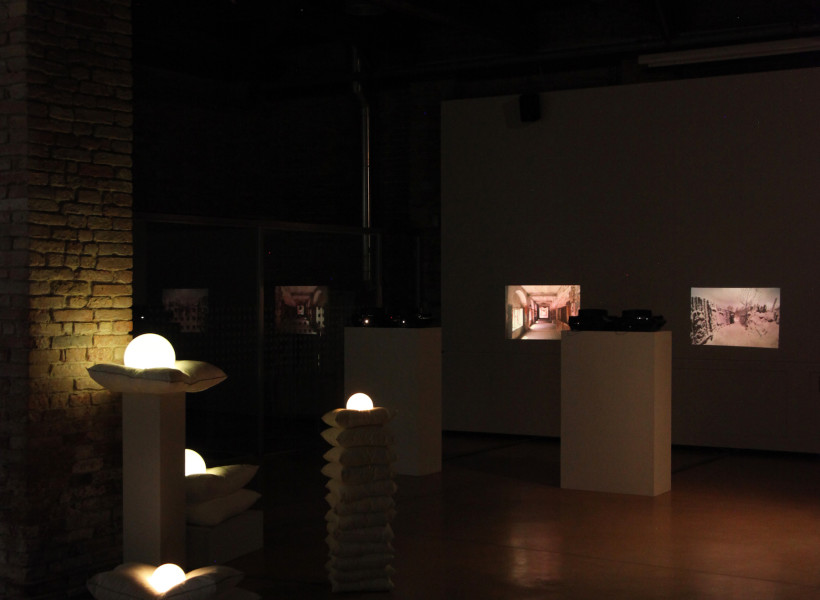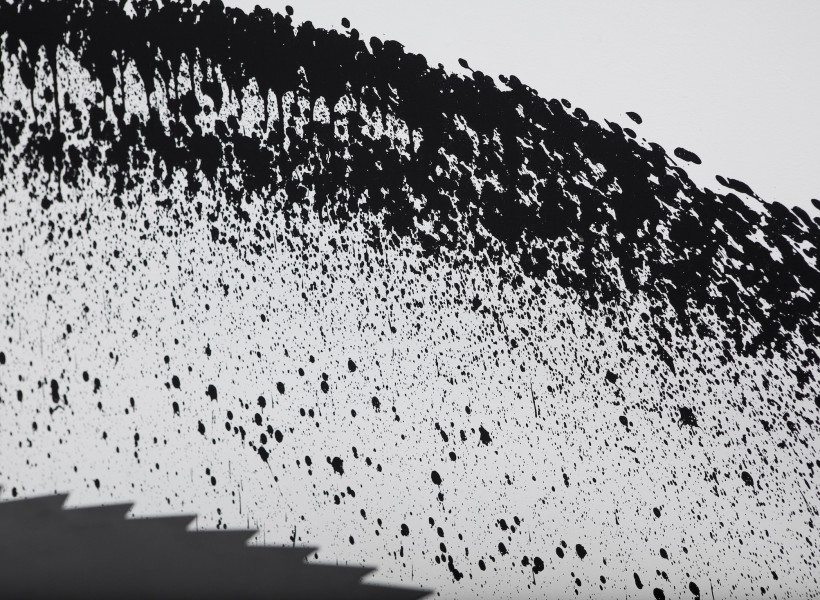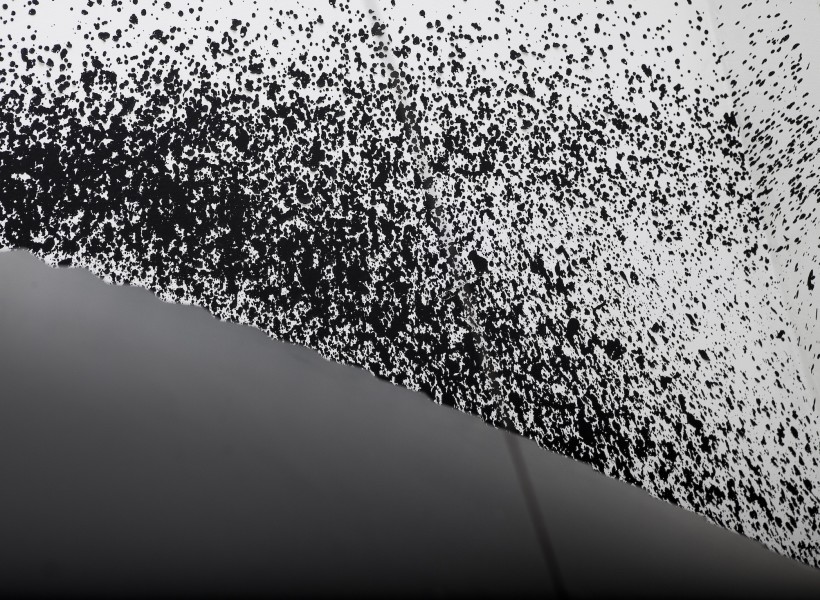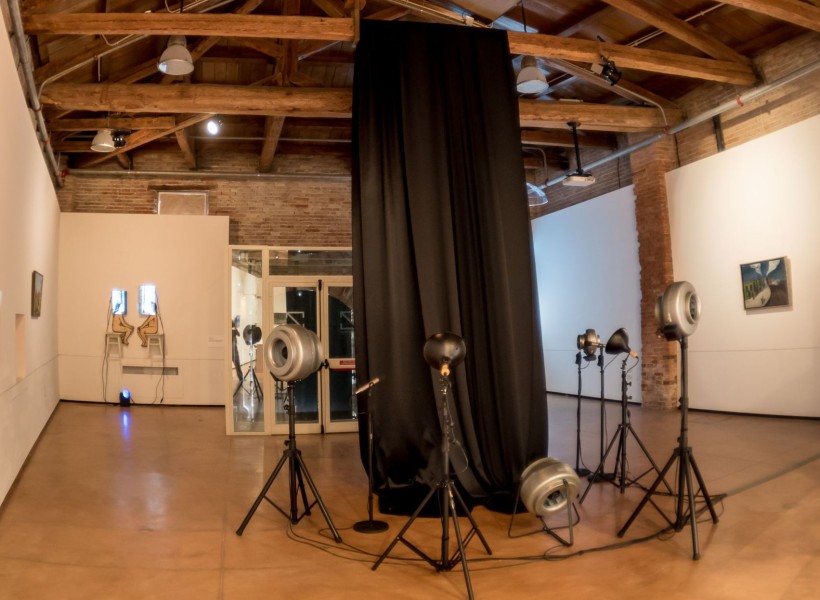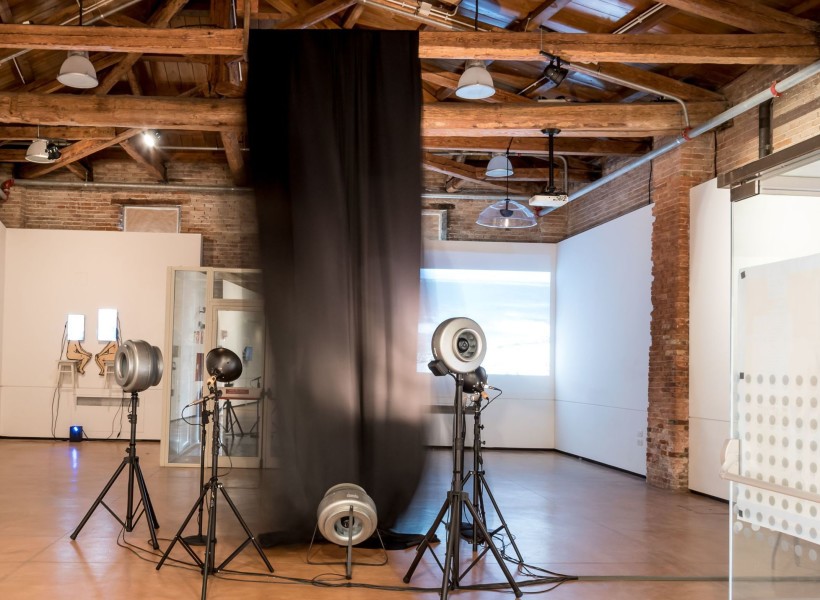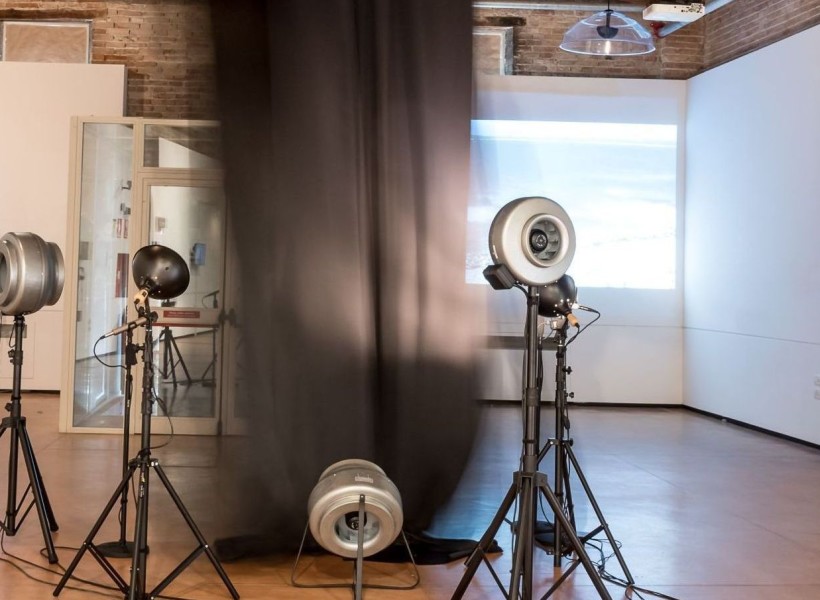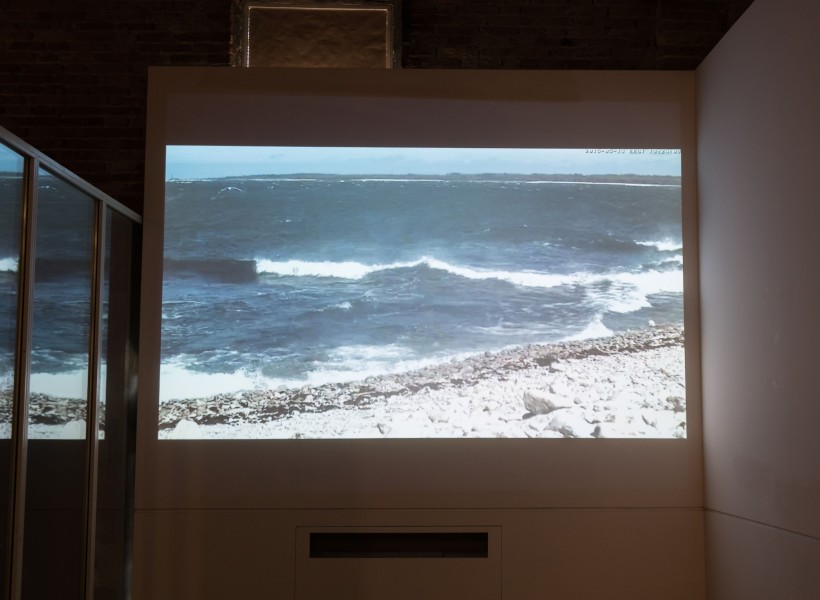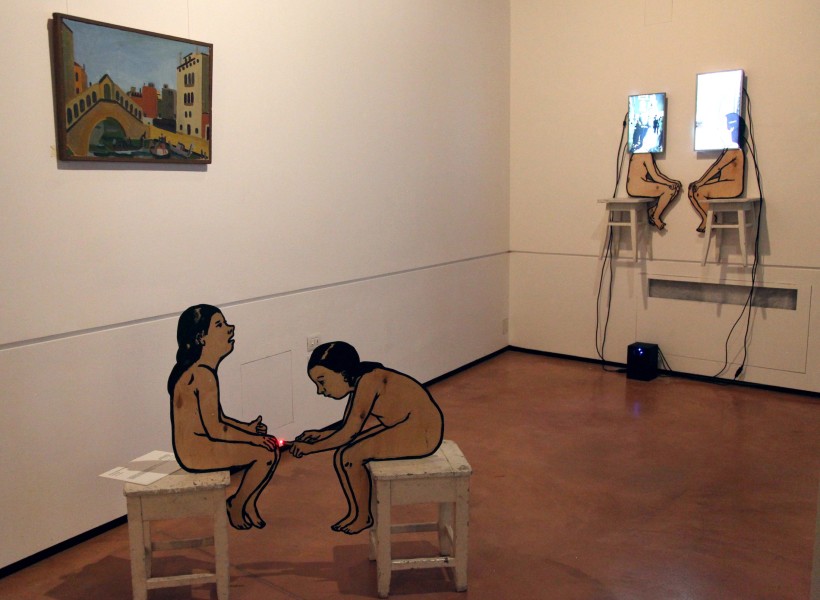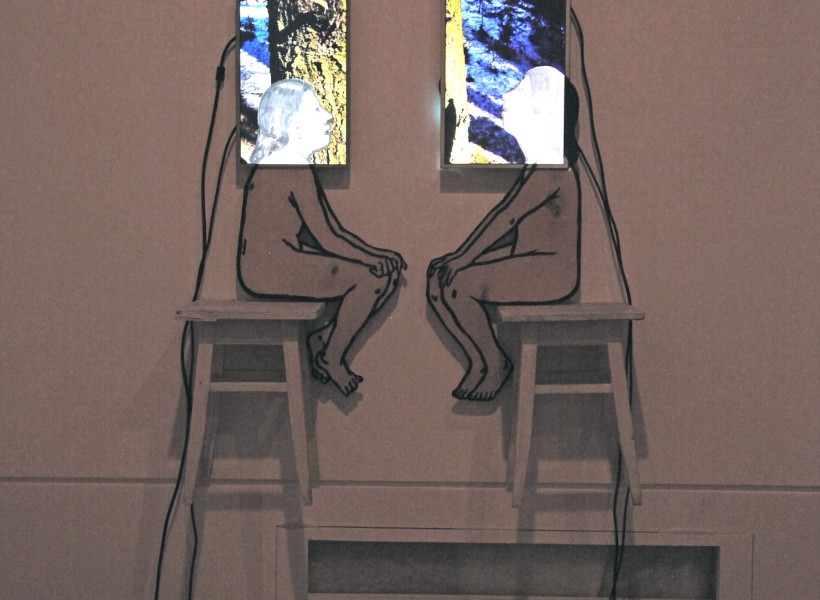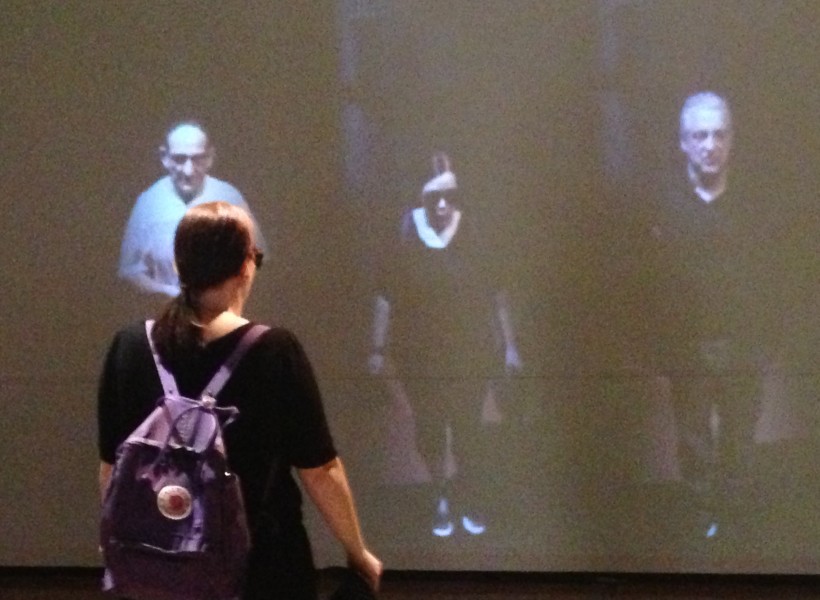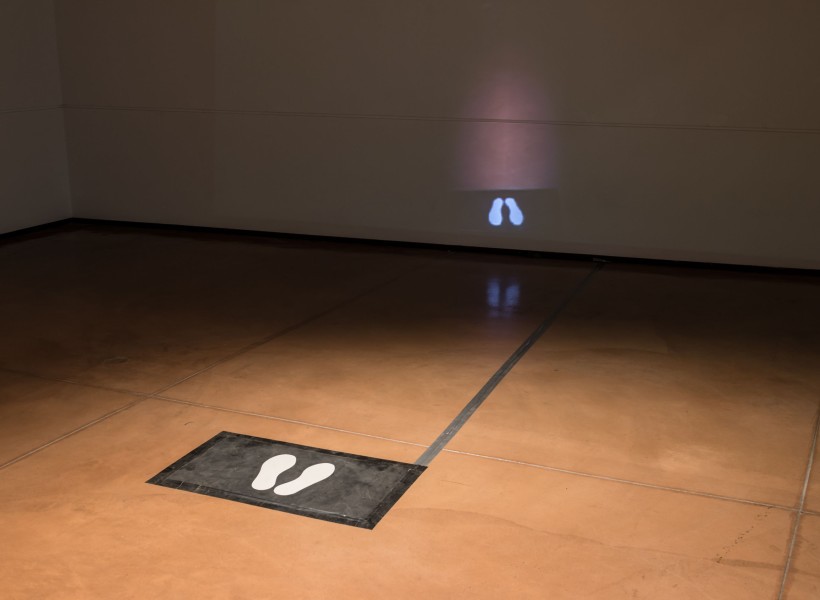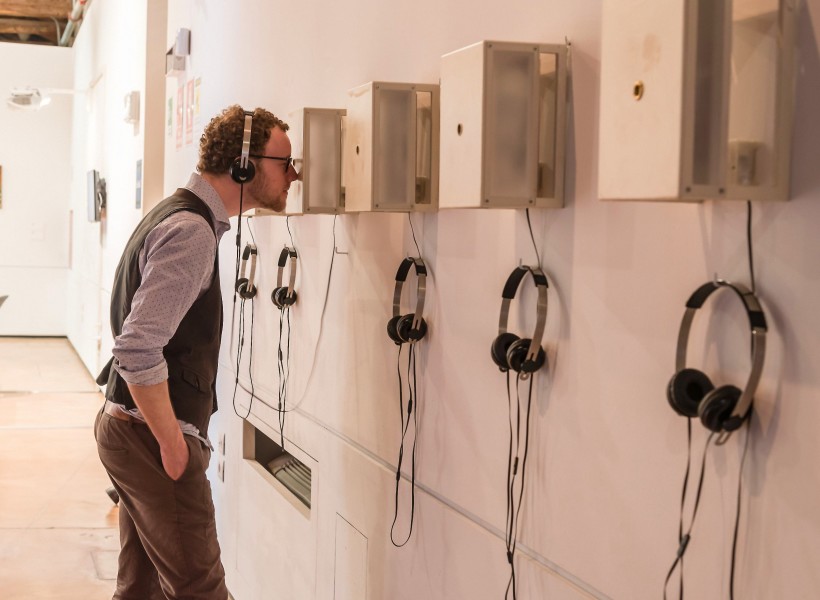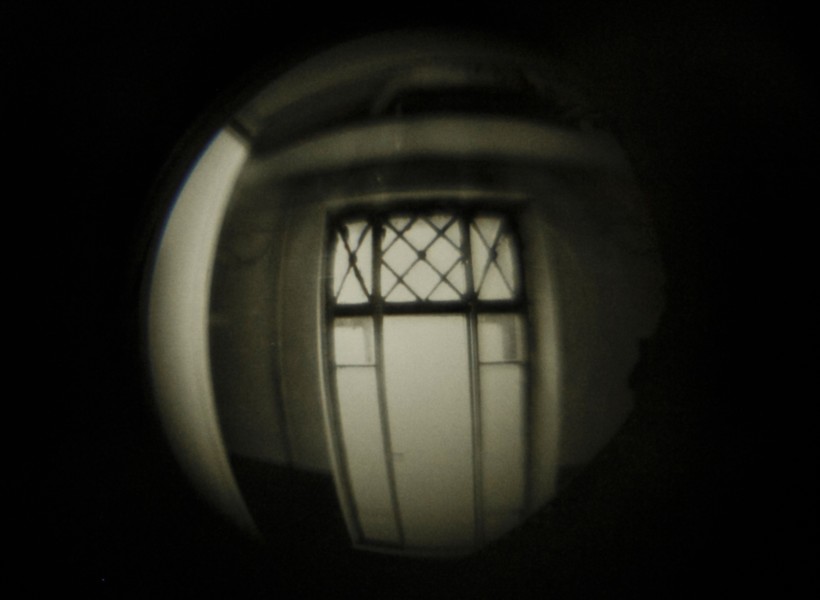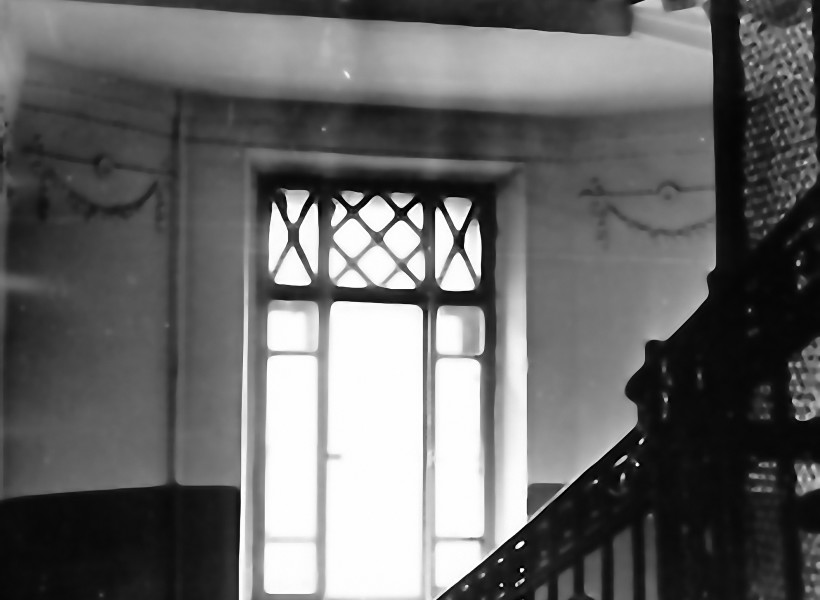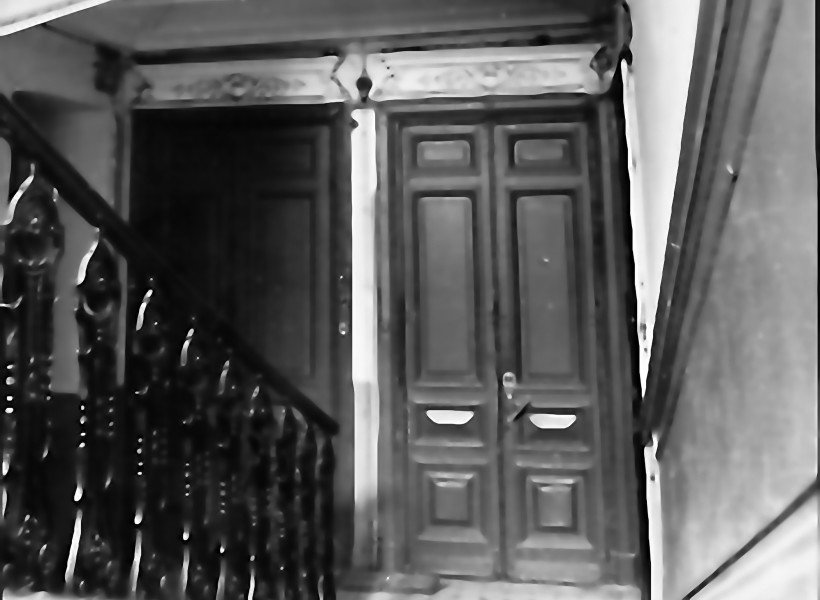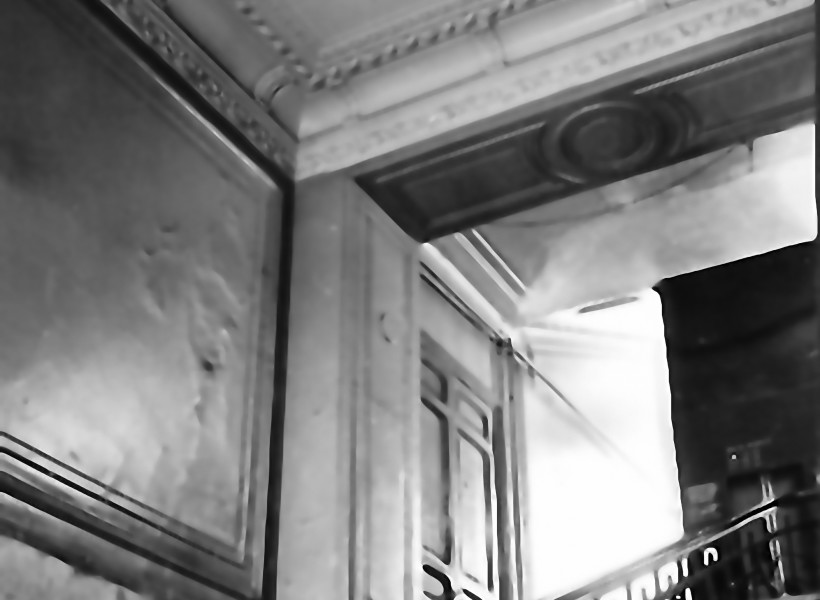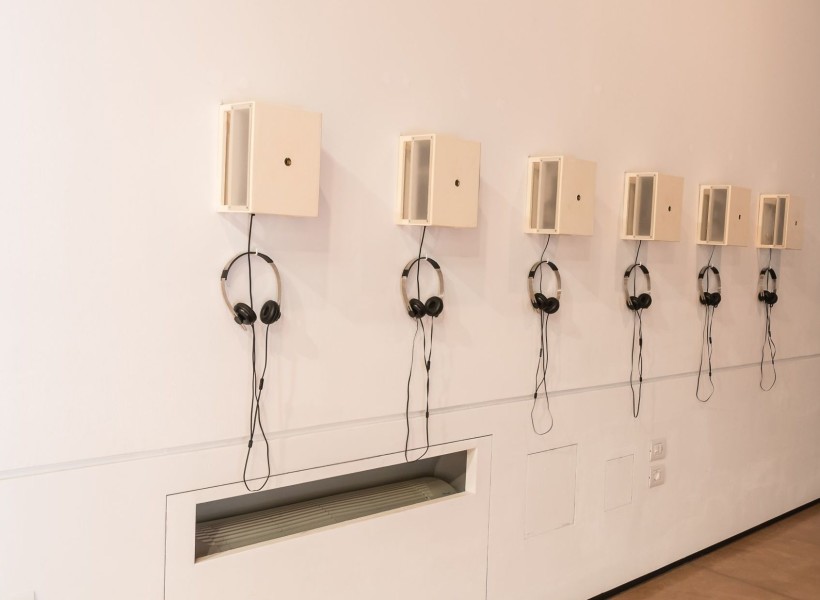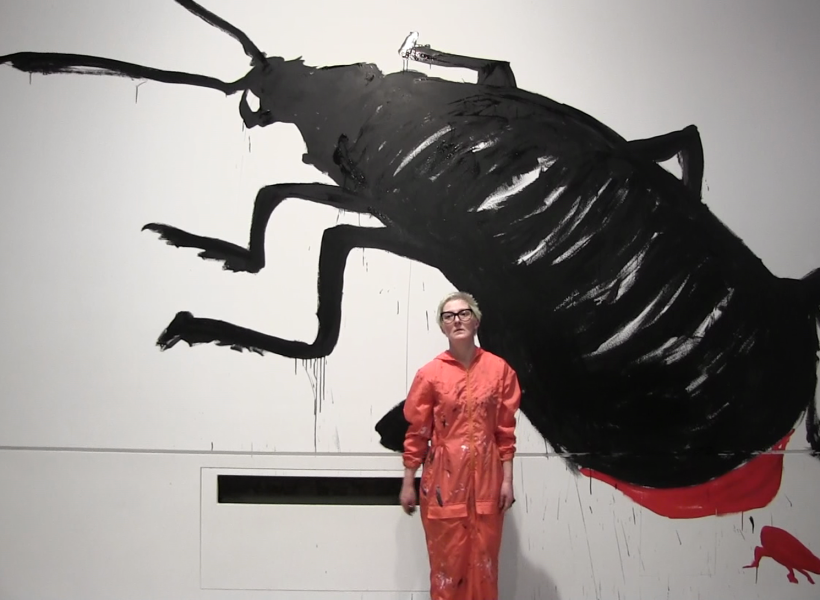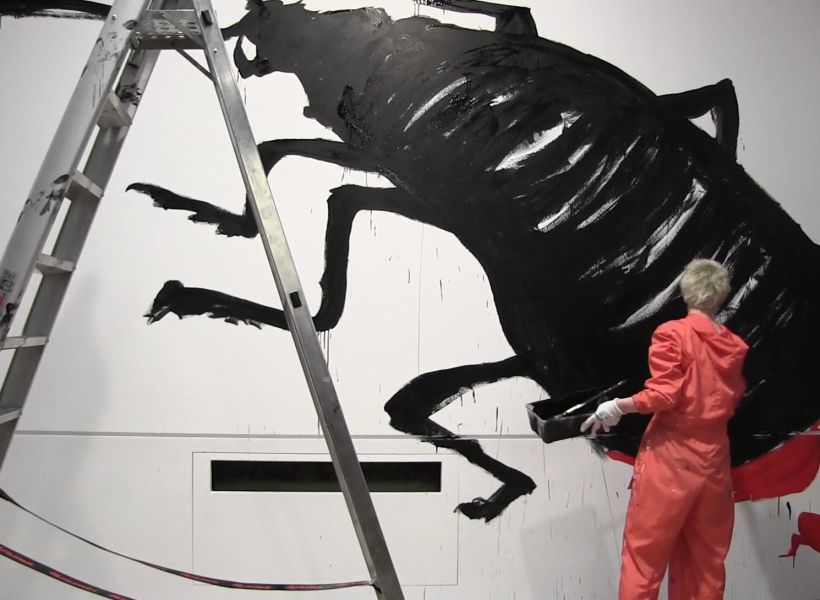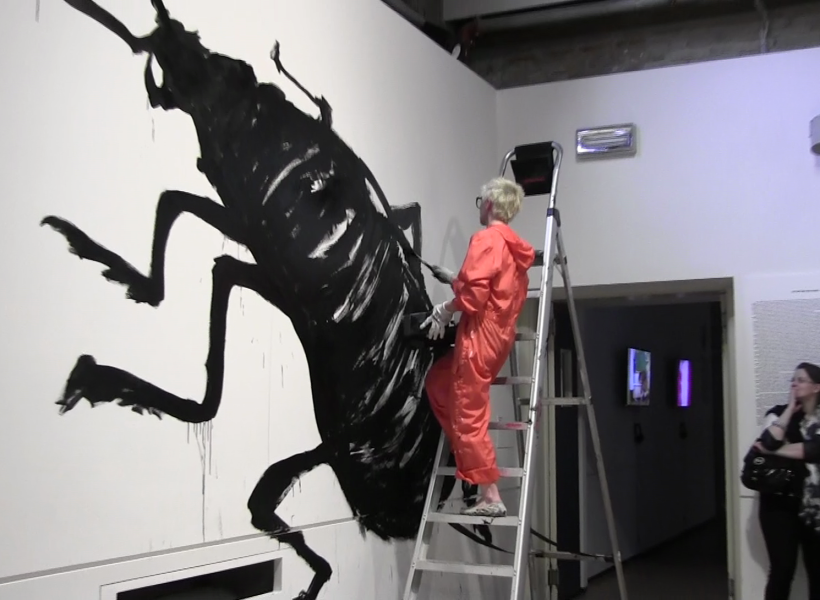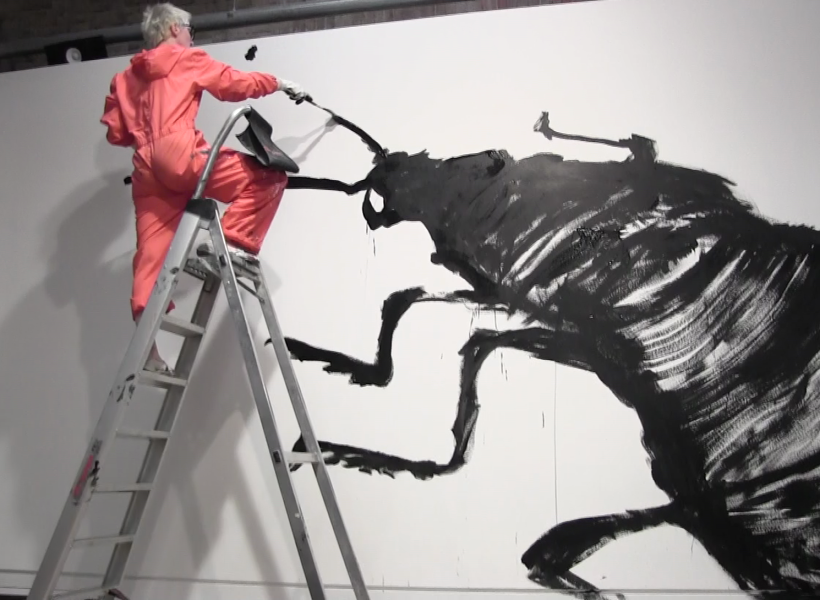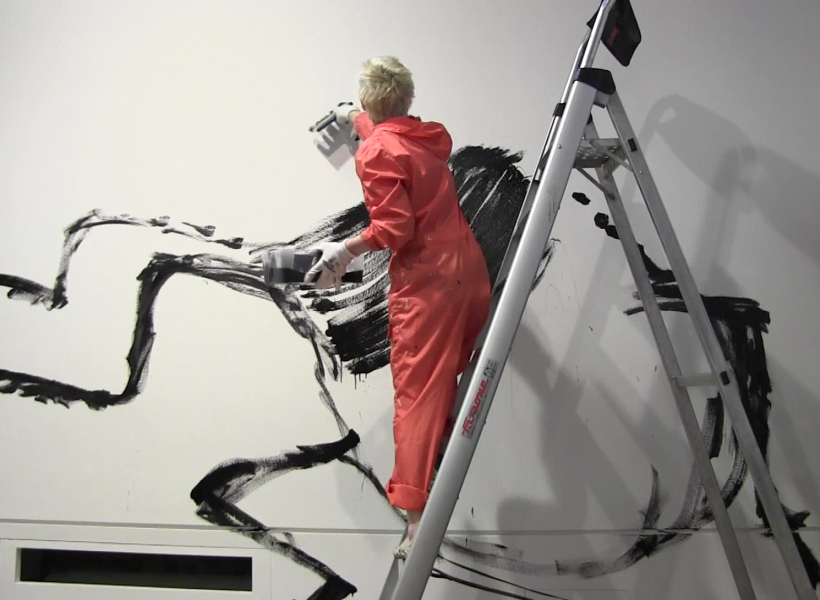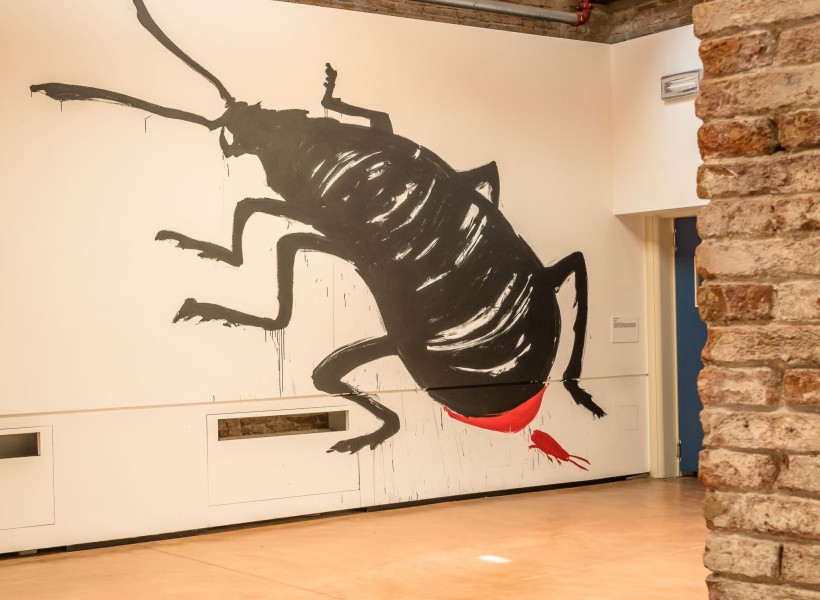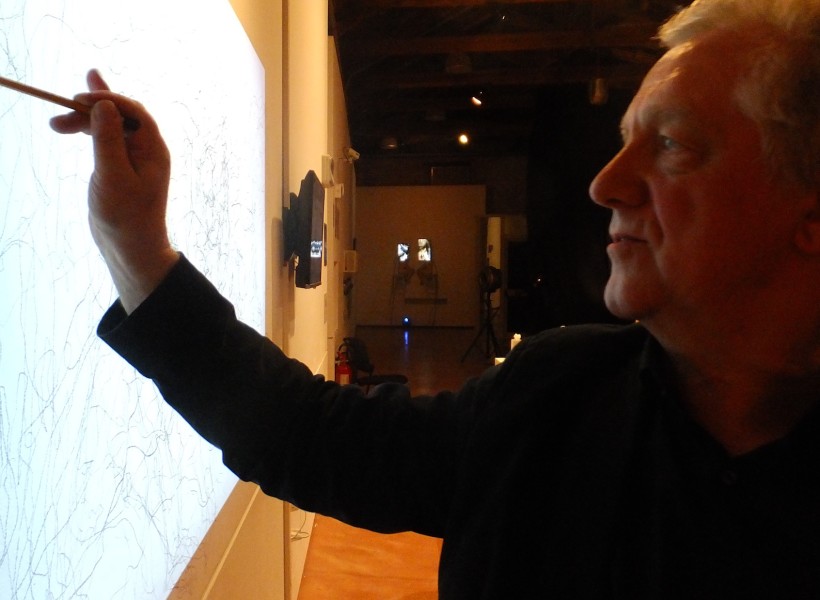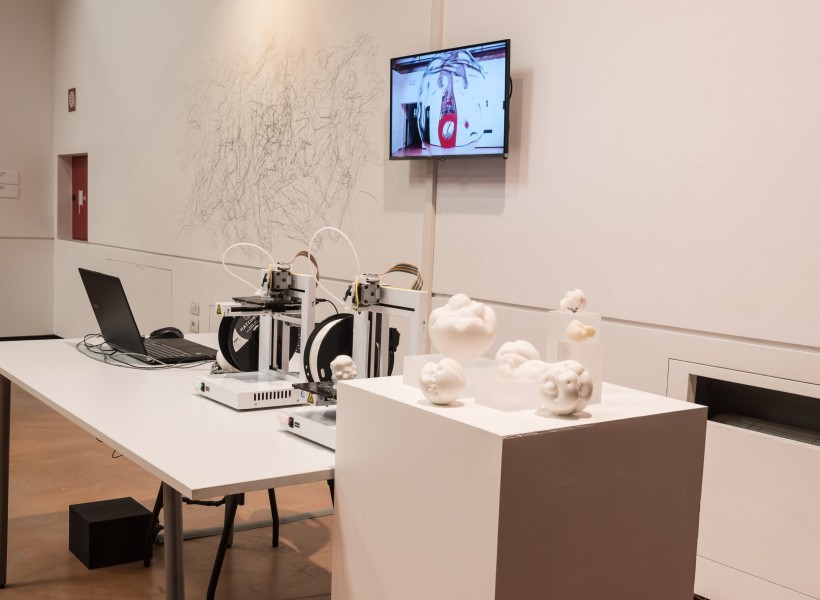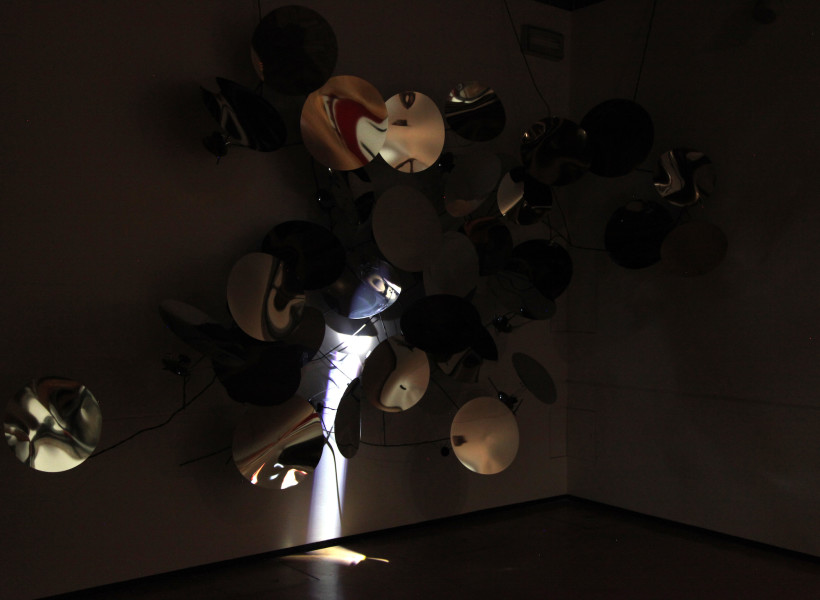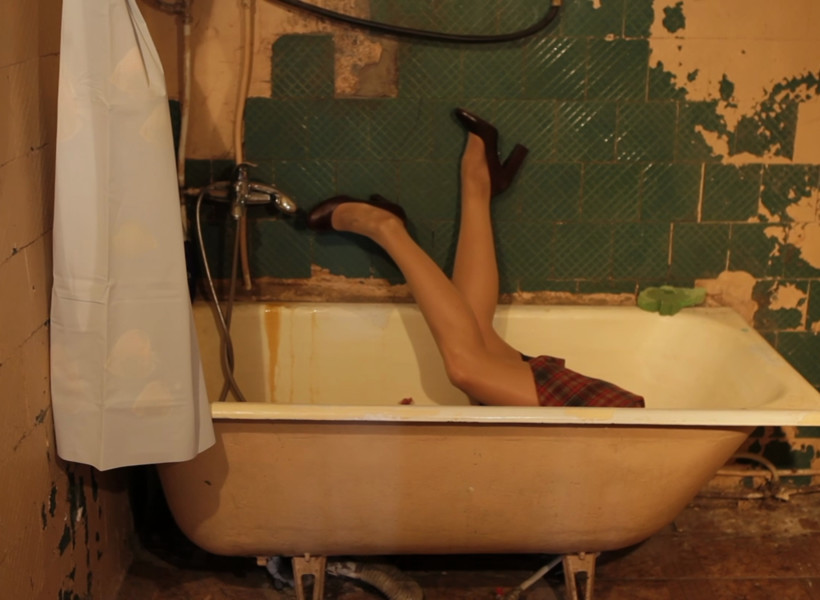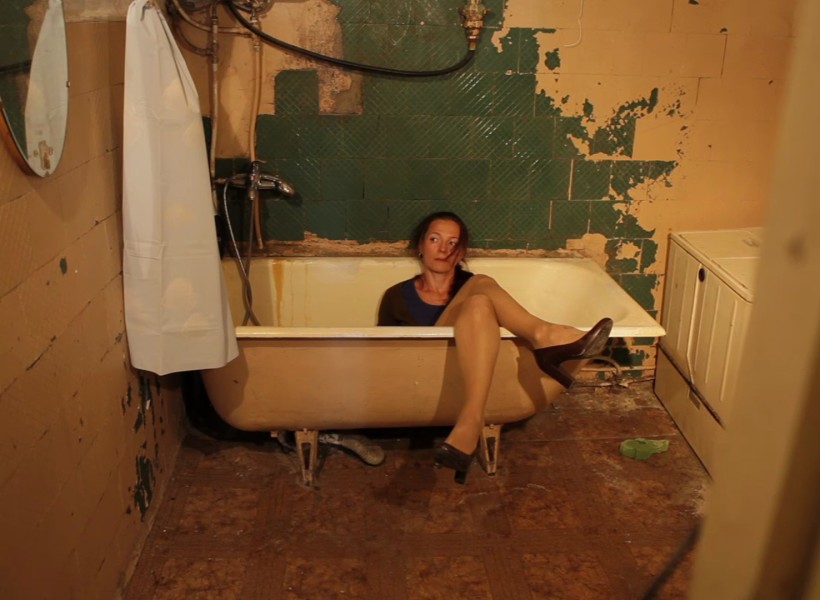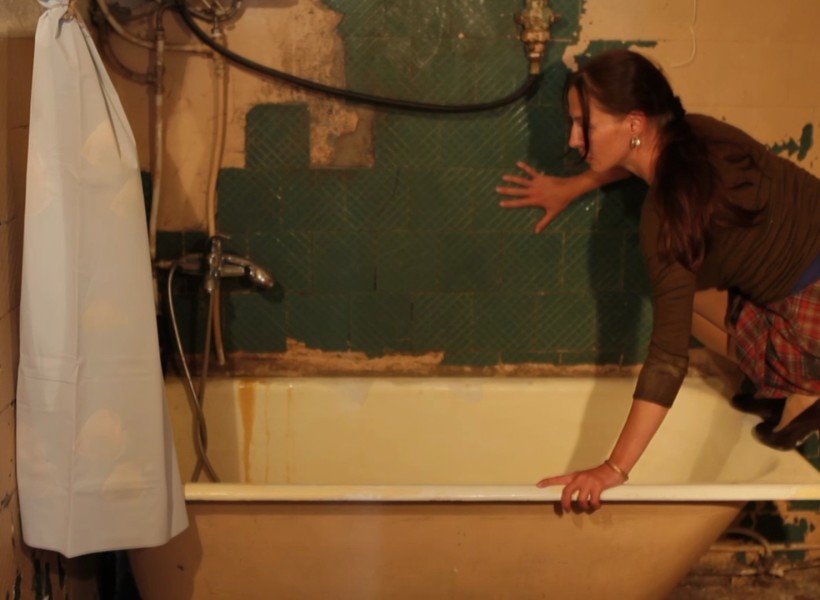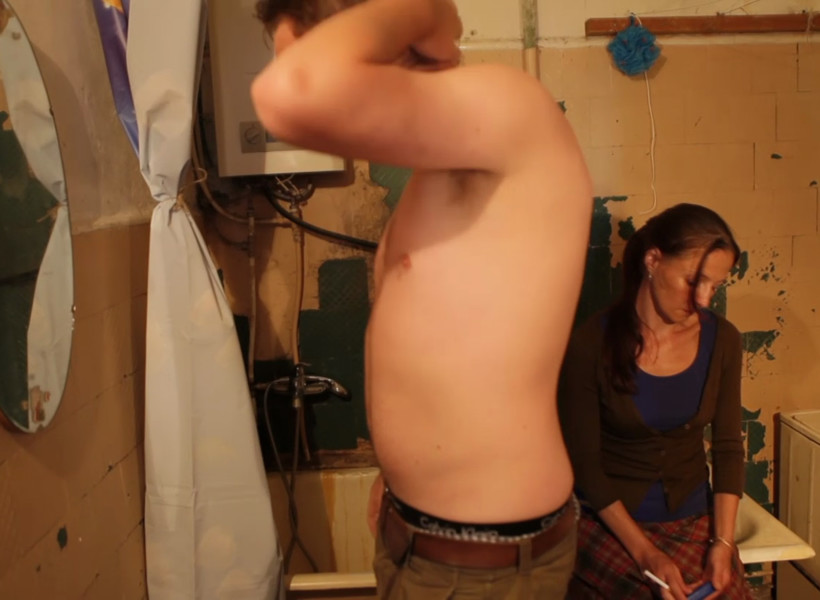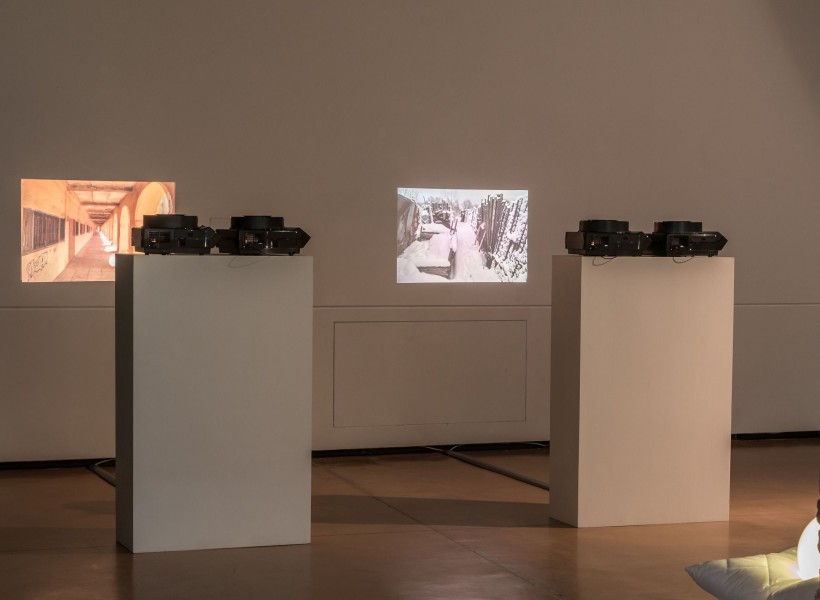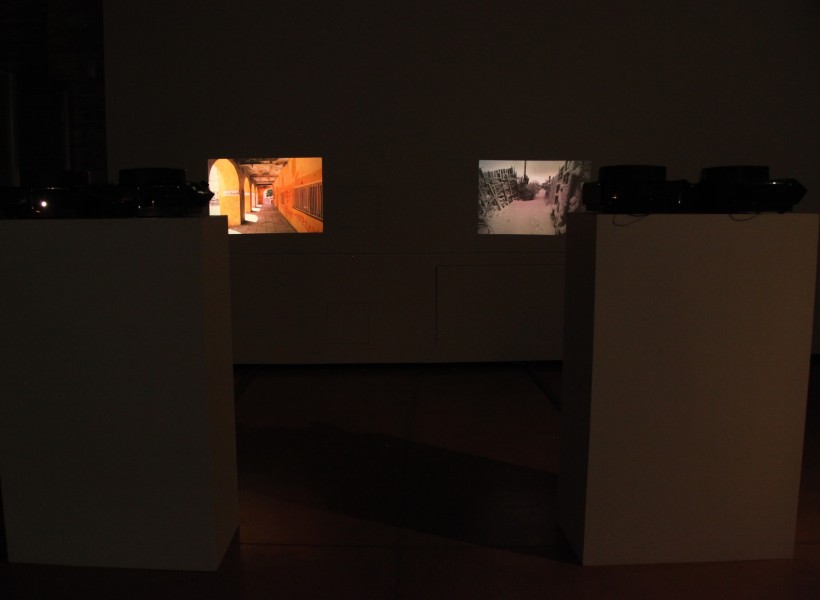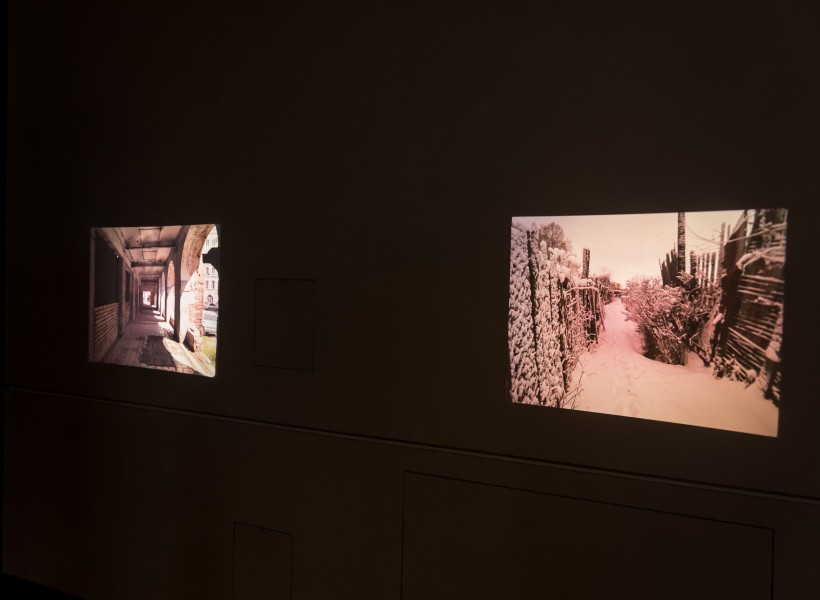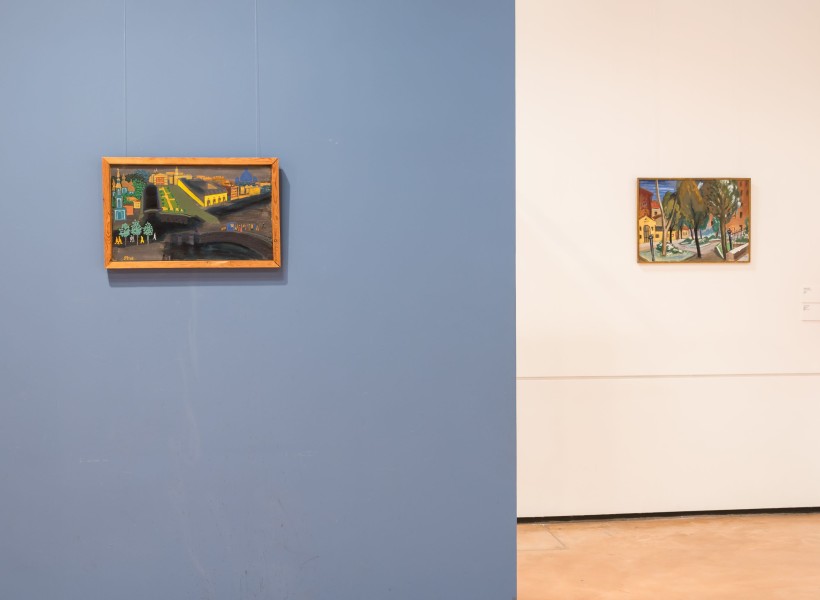Exhibition: May 8th – July 5th 2015
Curated by Elena Gubanova, Silvia Burini, Giuseppe Barbieri, Natasha Kurchanova, Anna Frants
Artists: Vitaly Pushnitsky, Petr Belyi, Anna Frants, Daniil Frants, Alexander Shishkin-Khokusai, Alexandra Dementieva, Ludmila Belova, Marina Koldobskaya, Elena Gubanova, Ivan Govorkov, Victoria Ilyushkina and Maya Popova, Mariateresa Sartori, Alexander Terebenin
Laputa
Oh, laugh, the laughers!
Velimir Khlebnikov
In the quiet of a library dusk
Ancient leaves glimmer,
They are forbidden like drugs,
Like poisonous flowers.
The life is there, but a different life.
The brush is bold, the color is bright,
The fiery fairy-tale is true,
The tale is real, life is a dream.
It’s true, but the echo will not bring
A joyous din, will not reply.
The Earth, unused to laugh, to sing,
Rides on business along the sky.
The title of the exhibition, On My Way is intentionally open-ended. It hovers between the poet Roald Mandelstam’s two kinds of life, both derived from fantasies: a bright and colorful one hidden in books and Laputa, Jonathan Swift’s imaginary flying island populated by intellectuals and ruled by men, where “The Earth, unused to laugh, to sing, rides on business along the sky.” For Mandelstam, these two opposing images correspond to two types of “lives”: a forbidden and “different” one, belonging to art, and that of the everyday existence devoid of art. His friend Alexander Arefiev vividly displayed the first kind of life in his painting I am off to Get a Beer, which celebrates Leningrad, now St. Petersburg, Arefiev’s native city. It is a painting demanding considerable degree of absorption in the work for its viewing enjoyment. We see a vast architectural vista opening before our eyes, inviting us to survey the tasteful grandeur of the metropolis with its low skyline, classical buildings, and granite embankments. Human figures appear almost as non sequiturs, dwarfed by the grandiosity of the setting. Their multicolored silhouettes appear in the middle ground in two nearly symmetrical clusters – on the left in the intervals between the trees and on the right standing in line in front of a beer kiosk. In 1960s and 1970s, the decades in which many of the exhibited canvases werepainted, getting a beer was a popular social ritual, allowing inebriation as a way to relax and escape from the pressures of the everyday. More than the content of the painting, however, its very form is directed toward this goal. When we see the work, we become completely taken by its image. As art historian Michael Fried famously observed in connection with the 18th-century French landscape paintings, a viewer standing before such a work is no longer mentally in front of this painting, because he or he is being effectively drawn toward and into it by its fiction: its formal devices, which include the play of perspectives and demands complete visual participation in the depicted scene.
Arefiev and Mandelstam knew each other well – so well, in fact, that they were buried in the same tomb in a Leningrad cemetery. Living in post-war Soviet reality and socializing in the same circles of non-official artists watched by the KGB for their insubordination to the rules of the Soviet community, they share the same concern of connecting earth and sky, finding respite in art from the deadening routine of the everyday and the “business” of a continuous struggle for survival. They remind us that dream is a necessary part of life — “the tale is real, life is a dream” – and should be accorded as much attention as questions of economic production. If in his poem Mandelstam inserts creative action – even as seemingly passive as reading a “forbidden” book — as a wake-up call and a jolt to the deadened senses, Arefiev views freedom as the very unproductive act of getting drunk in the middle of the day, when socially conscious workers spend their days toiling on behalf of the motherland or simply making the ends meet. Apart from their shared concern for subjective expression, both the poet and the painter are preoccupied with the perfection of form: for them, precision and elegance of styleis the sole vehicle for carrying out their task, the guarantee of its success. Mandelstam turned to the legacy of Acmeism, a turn-of-the-20th-century poetic school, with its measured rhythms and references to Classical Antiquity, to craft his delicately balanced verses. Like his friend, Arefiev borrowed his vocabulary from turn-of-the-20th century movements, albeit not in poetry but in the visual arts, buildingup the surface of his work by usingthe bright colors and simplifiedshapes of the Fauves and Cubo-Futurists, turning away from propaganda and performativity toward the internal dynamic of the work.
The same is true of the works of the Arefiev Circle, a group of artists formed in the late 1940s-early-1950s in post-blockade Leningrad, which included Rikhard Vasmi, Valentin Gromov, Rodion Gudzenko, and Sholom Shvarz among others. Just as I Am off to Get a Beer, the four paintings of the group included in this exhibition celebrate the city by drawing the spectator into the depicted scene, thereby increasing the viewer’s absorption offered by art and minimizing the dramatic, theatrical element of the relationship between the viewer and the work. That is to say, these paintings make us identify with the scene through an imaginary union, either joyful or melancholy, and not to judge it in confrontational manner. In Vasmi’s Venice, for example, we are invited to enjoy a sunny Venetian day, with its azure-blue sky reflecting in the water, gondolas crowding the canals, and an impossible covered bridge, the kind that cannot be found in the actual city of the artist’s dreams. Vasmi has never been to Venice, but lived his entire life in the place known as “the Venice of the North.” It is not surprising, then, that his cityscape resembles St. Petersburg/Leningradwith its granite embankments and low-rise buildings more than it does its legendary namesake. Gudzenko’s On the Platform also brings us into the atmosphere of the city’s life, but unlike Arefiev and Vasmi, he does not show us itsbright, pleasant, and relaxing side, but rather the gloomy grind of the everyday routine. We are at a station where people stand along one train that is about to depart, while another one is pulling out leaving puffs of smoke behind in freezing air… A man is trudging along the side of the platform, half-bent to the ground under the weight of an enormous bag, his face turned away from us as is everyone else’s in the picture. Although Gudzenko’s work includes more human figures than Arefiev’s or Vasmi’s, and he paints them at a closer range, they still exist apart and away, not looking at us or challenging us with their gaze. Even Sholom Shvarz’s Untitled, which is the only work focused specifically on a group of people who are engaged in a rigorous dispute, demanding something from an invisible authority left outside of the picture plane, depicts it in such a way that weobservethe angry crowd from aside, dispassionately, without getting involved in the heat of the moment. Gromov’s Sleep is, perhaps, the epitome of absorption into the realms of imagination and metaphoric abstraction. The artist shows us the sleeping figure from the back. We don’t know who the sleeping woman is or what she is dreaming about; all we can see is her stark nakedness, which makes her vulnerable, but also deeply human. When we look at Gromov’s painting, we are entering the imaginary world of the sleeper, which becomes our world. The artist’s task is precisely to draw us into the picture to the maximum extent possible, which he successfully achieves.
For Arefiev and his group then the phrase “I am on my way” could mean “I am off to get a beer” or off for a walk in the city, off painting, imagining, and enjoying what I see. For the them, On My Way designates movement not as dvizhenie, a measurable property of physical objects, but as an intensely subjective action in its psychological sense that opens up possibilities for individual freedom to feel and explore the imaginary space of the work on the viewer’s own terms, without being put in a situation that she must like or dislike, accept or reject, argue against or comply with, all the while feeling pressured, frustrated, or coopted. These paintings dissolve our individual subjectivity, emphasizing the leading role of the unconscious, the place in which we feel comfortable and cozy, because usually take it for granted.
A group of contemporary artists from St. Petersburgin this show shares this concern of their predecessors and compatriots with the spaces of imagination and absorption. Because it is impossible to eliminate every theatrical element from a form of visual expression, they make art that strives to strike a balance between displayand imaginative withdrawal. At first glance, a certain renunciation of the outside world may appear to be the result of such absorptive experience. In fact, however, the appearance of ignoring actuality is the result of an attempt to focus on the unconscious roots that connect artists who belong to the same place but different generations. The exhibition traces several ways by which such a connection between generations could be established. The curators of the exhibition organized it in such a way that each artist from the Arefiev group is assigned certain “successors” from his contemporary compatriots, with the idea their creative concerns have something in common. Because these creative concerns belong to the aspect of art that deals with the unconscious and is therefore hidden from direct observation, the task of the viewer in this situation is to find a link between the generations of artists not only on the visual, but also on an intuitive level, taking special care no to separate intuition from intellect. Partial descriptions and explanations of the works of the exhibition’s contemporary contingent are given below as a way to facilitate this process. A brief look at Vitaly Pushnitsky’s list of exhibitions, for example, reveals that he, like many artists, is concerned with issues of space, time, and light, and the way these traditional painterly concerns can be explored in other media, such as sculpture, architecture, or installation. At this exhibition, Pushnitsky is presenting Falling Light, an installation of fluorescent lamps that resemble a stairway leading usto the sky. Pushnitsky’s iconography and his obvious reference to Dan Flavin in his choice of material suggest a spiritualized message: no matter how difficult life is in this world, there is nothing wrong in believing that there is a way to heaven. In his unabated dedication to the creation of a space to dream, Pushnitsky opposes himself to someone like Ilya Kabakov, who, in his work How to Meet an Angel mocks precisely such a striving.
In Dream and Ball Petr Belyi also literalizes the idea of a space for dreamsby placing large luminescent balls made of opaque glass upon stacks of pillows. A room filled withspheres exuding soft light reflecting on white surfaces of pillowsmoves usinto a surreal bedroom where we can walk around the delicate constructions and examine them as closely as we want. Careful scrutiny of the materials, however, will not bring us closer to the meaning of the work, which is a symbolic reminder of the importance of dreams in our lives. The artist reminds us that each person dreams differently: “Monotonous light emanating from the ball is the dream of a person whose consciousness is clear. Quiet and deep glow is the sleep of a child; nervous, quivering and cold – sleep of a criminal; bright yellow light – sleep of a president; greenish light is the sleep of a homemaker. The ball is resting on a pillow; it sleeps.” Similarly symbolic is Belyi’s other work, Pause, which is made of a circular sawblades held at various levels by thin steel cables. The walls of the room are splattered with black paint resembling dry blood. According to the artist, the precariousness of the suspended position of the sawblades in mid-air paired with the sight of splattered walls is meant to make people uncomfortable and vulnerable, making them freeze in horror, in anticipation of asound of moving saw blades. Pause has been conceived as the symbol of Russia’s brutal history and the wounds it leaves in people’s psyches.
Anna Frants’ Anxiety deals in part with the same task of the creation ofspace for a distinct feeling, but usually that of unease and discomfort, which, while instinctual, is also highly structured, because it is artificially produced. With the help of a few props, she creates an emotionally disturbing atmosphere with blowing drapery, wind, and frightening sounds. According to the artist, this work is “an allegory of anxious states: there is no love, no compassion just anxiety.” When she creates feelings of anxiety exclusively through materials and without the intervention of drama and theatricality, Frants makes the viewer concentrate on her gut reactions to stimuli, which may signal approaching danger. Weather Forecast is an installation, which accompanies Anxiety, because it requires the accompaniment of the sounds of its twin installation. The video of the forest for Weather Forecast was taken at the shoreline of the Estonian coast of the Baltic Sea. According to the artist, the two installations go together because “an artificially created audio sequence of the kinetic installation Anxiety, readable in real time, evokes an uneasy feeling and demands an alternative – the eternal grandeur of sea, forest and its inhabitants.”
Instead of suggesting imaginary spaces of existence, Alexander Shishkin-Hokusai makes them literal by inventing and setting them up in front of the viewer. The expressive dynamics of Shishkin-Hokusai’s work derives precisely from this juxtaposition between the spaces of the imagination and those of reality. An artist who worked much of his life in theater as a stage designer, he stages scenes with “actors” – smaller than life-size human figures, which he makes out of plywood. In Let It Be, these roughly hewn miniature figures crowd around various parts of the gallery space, creating situations that look ordinary, but also strange. For example, some of them seem to be hard at work performing such an ordinary activity as cleaning. However, a woman at the feet of which they are hard at work scrubbing looks as taut as wire and ready to fly off into space. In another scene, working attentively and conscientiously, a woman examines the back of an enormous rat. In Star Landing, Shishkin-Hokusai places these cardboard figures on top of stools and crowns them with video monitors resting on their shoulders. Their heads, meanwhile, appear on these screens as video recordings filmed against a variety of backgrounds, such as rooms, forests, or cityscapes. The artist describes his attempt to juxtapose the worlds of the imagination and reality as follows: “This installation examines a border condition of being in two worlds – I am here and I am there; I am static and I am dynamic. The video contains documentation of the artist’s project, when he inserts his heroes into the midst of actual people thereby creating the situation of them being either accepted or rejected [by the community]. It also contains the opposing experience of filming his heroes surrounded by wild nature.”Although much more satirical than other artists in the exhibition, Shishkin-Hokusai’s desperate mockery of his fellow human beings has a touch of tenderness to it. His cardboard figures may be ridiculous and pitiful, but they are also vulnerable and earnest, which may redeem their silly awkwardness to some extent.
Alexandra Dementieva and Liudmila Belova focus on the link between representation and memory filtered through the use of various technologies. Dementieva’s Mirror’s Memory invites people to stand in front of a screen in a dark room on which images of visitors are projected. It is not exactly a mirror, but a reflection of one’s appearance created on the computer. The viewer can see himself in real time, but a step on carpet in front of the screen triggers a reaction that records himon the computer and releases recordings of other people who were in his place. The computer is programmed to release the recordings randomly, so a residual image of hisrecording may or may not show up in front of this person or someone else. In Dementieva’s work, a person’s private existence becomes visible through a delay in time, as a representation or even as a remembrance, spirit or phantom. In Belova’s Archive, the memory of the body is evoked not through its visual image, but mostly by auditory means. Here, the artist makes us peer through peepholes in uniform wooden boxes in which we can see photographs of entry halls into old St. Petersburg buildings. The images were found by Belova after they had been discarded by a real estate agency. Each box is equipped with a set of headphones, transmitting sounds associated with the life in each particular building: music, steps, fragments of conversations, falling water… While in this work photography and the magnifying glass of the peephole create an infinite distance between the viewer and the viewed, audio-technology becomes the main tool that bridges this distance, connecting the vision to the body and creating a nostalgic reminder of a particular time and place.
In contrast to many artists in the exhibition, Marina Koldobskaya does not mount technically elaborate installations, but paints elemental things – flowers, animals, fruit, faces – using deceptively simple technique and basic palette. In her performances, she creates murals revealing to the curious eye the tricks of the painting trade: how to make an illusion with minimal means of paint and brush and how to do so in such a way that it becomes powerful and convincing. She starts just with a few movements of the brush, laying the ground with white primer, which looks like an abstract daubing, upon which she splatters some red paint and outlines it with black. Gradually, her forceful lines and distinct marks assume a certain recognizable shape, which eventually turns into a fully developed figurative representation. In their primitivizing style and effective presence, Koldobskaya’s murals recall cave paintingmore than anything else, and her practice of performing painting makes her one of the most theatrically inclined artists of the group.
Ivan Govorkov is another performer in I Am on My Waywho appears to be more theatrical rather than absorptive. In the Model of the Mind, Frants and Govorkov demonstrate directly “… the dialogue between generations of artists. Ivan Govorkov, a professor of art at the St. Petersburg Academy of Art and a virtuoso draftsman handles his material expertly and with ease. The sixteen-year-old Daniil Frants is a young programmer who specializes in the creative use of new technologies. In this work the artist raises a very important question for today’s artistic practices: how possible is it to integrate technology and traditional art?”
In the Model of the Mind, Govorkov creates semi-abstract Surrealist imagery, drawingdirectly on the wall with his eyes closed, speedilycovering its expanse with curving lines and a variety of complicated shapes that are suggested by his unconscious. Daniil Frants works at a computer, converting Govorkov’s two-dimensional drawing into three-dimensional digital images with the help of a program he wrote. By adding virtual space into hand-drawn lines, Daniil Frants creates absolutely new objects. In the resulting sculptures, which are printed on a three-dimensional printer, nothing remains of their genesis as a drawing except the dynamics of their form. Despite collaboration, each participant of this dialogue stays in his own territory. The idea of the dialogue between generations consists of understanding that the intuitively created work by Govorkov and the controlled work by Frants rest on a common ground, because “freeing himself from any control, drawing the lines blindly, without premeditation, an artist does not reach freedom, but only reaches the understanding of its fictitious nature. The pleasure of such drawing and such freedom presupposes certain habits, training, and predictability. These are the premises on which Daniil Frants builds his work as well.”
With Gubanova, Govorkov made Danae, an installation whichreferences the Greek myth and the famous painting by Rembrandt in the Hermitage, where Zeus appears to his lover as a shower of gold. In this work, Gubanova and Govorkov link the myth to science by eliminating the literal reference and replacing it with an installation of reflective disks, which contract and tremble when a ray of light touches their surface. The explanation for this phenomenon is given using the terms of corpuscular and photon theory of light, but the import of the work relates to the original myth’s celebration of love as an immaterial and transformative force. In this installation, Gubanova and Govorkov attempt to “tie the algorithm of the movement of light with the algorithm of the movement of a viewer’s gaze when examining Rembrandt’s work [Danae in the Hermitage]. The trembling of the mirrors and flickering of the light reflecting off their surfaces creates an atmosphere of sensuality and eroticism that fills the space of the viewer and the work.
The two videos in the exhibition have a heavy dose of satire as well. Made by Victoria Ilyushkina and Mariateresa Sartori, tell stories relating to people’s sex lives, but in very different styles. Ilyshkina’s is a humorous allegory of a woman’s desperate existence in her short-lived relationships. The action takes place in a shabby bathroom with a tub, a sink, a washing machine, and two actors in each scene – the woman herself and various men who alternate plunging fully dressed into the bathtub with her. In each episode, the actors repeat their steps mechanically, with lackluster expressions on their faces. At the end of the video, when the woman is finally left alone, she carefully descends into white ceramic cavity head first, disappearing in it almost completely, save her legs dressed in stockings and fancy pumps. The heroine of the video is left nameless, literally coming undone by the boredom and meaninglessness of her relationships. In contrast to Ilyushkina, Sartori does not stage satirical scenes of spiritual degeneration, but presents libido theory as a popular chemistry lesson, taking Freudian metaphoric language literally by illustrating his theory as a “hydraulics principle,” which has strong connotations with flows and liquids. The deadpan lecturing style of the narrator and the scientific looking diagrams, charts, and experiments of the subject he teaches make a pun on the distance that separates an actual experience from a theory that offers its explanation.
Alexander Terebenin’s Gallery and Traces on White presents, perhaps,the most direct approach toaninterpretation of the exhibition’s theme. A series of photographs in Galleryshowsperspectival stretches of dilapidated colonnades of the Nikolsky Market in St. Petersburg, erected at the end of the 18th century. A companion series Traces on White displays empty paths in countryside’s equally neglected environment with its rickety fences and snowy fields. In these series, “journey into nowhere” becomes the subject of Terebenin’s work. Despite the sunny weather during which the photographs were taken, certain doom and decay pervade the images. Falling apart and abandoned, empty stretches of decrepit constructionsremind us of Russia’s imperial glory, a passage of time, and a certain attachment to specific places, which makes these ruins symbolic of a living history. Arefiev’s nonchalant walk through a glorious city in I Am off to Get a Beer turns into an endless journeythrough ramshackle structures in Terebenin’s images of abandonment and neglect. Despite a drastic difference in tone, however, the fundamental concern of conveying the person’s subjective attitude toward our environment remains the same. “I am on my way” becomes a metaphor for a passage of time.
Natasha Kurchanova
“The true picture of the world flits by”.
Walter Benjamin
Theses on the History of Photography
As it is evident from its title, the exhibition On My Way is about a journey, but a journey both global and strictly individual. The creative journey of an artist, journey of a generation – the movement in time and space as a factor that unites the whole exhibition. It is possible that it is not a well-known fact for the western spectator that the journey of a Soviet person was firmly restricted and controlled, starting with physical movements and ending with spiritual ones. Prior to the collapse of the Soviet Union, it was hard for Soviet artists to quench their thirst for what was going on in the art of other countries. Artists of the Arefiev Circle (Alexander Arefiev, Rikhard Vasmi, Sholom Shvarz, Valentin Gromov and Rodion Gudzenko) are no exception. They invented their own culture, built their own world as a haven, as a freedom zone. Not but what freedom is something that lives separately in each person. The internal freedom cannot be broken down, taken away or surgically removed as the soul was removed in the novel We by Yevgeny Zamyatin. Artists of the circle were not radical, but they were not conformists either. They lived, worked, every now and again “getting it in the neck” from the government, but they did what they saw right because they didn’t want to or knew how to do otherwise. Works of the Arefiev Circle exhibited in Venice are not so much the story of an artistic union as that of one generation that was free in spite of any of the surrounding conditions. And that freedom is the second factor that unites the exhibition’s participants.
The connection between generations shines through both in individual works and in the show’s entire structure. Paintings by the Arefiev Circle that have been long considered classical in Russia intersperse with works by contemporary artists who use new technologies in their art. The language and means of expression change, but the subjects and issues that interest people remain the same. And no technologies or years that zip forward are capable of destroying the warm-heartedness that shimmers in every work at the exhibition.
The exhibited works could be united into several groups according to visual and conceptual characteristics, which is accentuated in the show itself. Rikhard Vasmi, a member of the Arefiev Circle, painted a Venetian landscape in the 1970s while he had not been in Venice even once. The Rialto Bridge, gondoliers, low-rise houses, clear sky and green water: the similarity is obvious, but Vasmi’s Venice looks like St. Petersburg, as if, instead of the countless number of shades of grey, the city had been filled with sunlight. The vital necessity of the Arefiev circle to create their own world and to mythologize their existence manifested in this small landscape. The impossibility of physical travel to Venice activates the whole potential of imagination. And, it would seem, why fly somewhere if you are there as it is? This subject of presence-absence makes the work of Vasmi akin to the video installation Star Landing by Alexander Shishkin-Hokusai. Two flat plywood young ladies sit in front of each other on stools, and their heads are in TV sets. It seems that the girls discuss where they have been: one went to a museum and walked around the city, and the other went to a winter forest. We are present at this dialogue, but, at the same time, we are alien-ated from it. The work comprises three layers of this presence-absence. The girls, much like the spectator, find themselves in the exhibition hall and, simultaneously, they each saunters in her own space, one – in a crowd of people, and the other – in a complete solitude, but, at the same time, they are absent from both the hall and video recordings.
Ludmila Belova in her audio installation Archive balances at the same verges of presence-absence, visible-invisible and statics-dynamics. Six boxes with peepholes and headphones conceal black-and-white photographs of staircases, distorted by the peephole’s optics. The imprecision of sound and picture – everything is heard and seen from some distance and, making its way through the unconscious, it drags up the viewer’s own archives, and the viewer constructs his own memories.
The landscape On the Platform by Rodion Gudzenko is close in its mood to the media installation Anxiety by Anna Frants. The general state of uneasiness: in Gudzenko’s case, it is characteristic of a train station: all people are in a hurry, they are dragging their bags and suitcases, saying goodbye, saying hello – as long as they make it to their trains; in Anna’s, it’s an engineered show, in which the leading role is played, it would seem, by the blowing drapery, lit up and guided by air gusts, but, in reality, the action is built on a feeling of anxiety that overtakes the viewer who looks at the installation. Weather Forecast is the second part of Frants’ statement, in which the webcast from the Estonian Coast of the Baltic Sea becomes a counterbalance for the anxious feeling. It is the grandeur of nature against the programmed-improvised sounds of the rustling fabric and ventilators.
The crowd that screams at somebody from above in the painting Wall by Sholom Shvarz exemplifies the impotence and fear of ordinary people before the omnipotent authorities, but also the unwillingness to obey them unthinkingly. Its title, content and degree of tension are close to the protest album of the same name by Pink Floyd: the righteous indignation and fear as well as a practically reflectory attempt of self-defense. A similar acuteness of emotions is present in the works of several other artists.
A deliberate simplification of subjects and images in the drawings by Marina Koldobskaya is also preserved in her mural painting La Cucaracha at the exhibition in Venice. The big black cockroach is, according to Kabakov, a precise symbol of the Soviet communal household. It is the character of many children’s stores and rhymes that has practically disappeared from the face of the earth. It is the intimidating past, seemingly harmless, but, in substance, comparable to real epidemics.
A virtually ringing sensation of fear accompanies the installation Pause by Petr Belyi. Circular saw blades, frozen for a moment, and dried drippings of black paint on the white wall signify the precarious balance that, as we all thought, has been achieved in our country and all over the world, is apt to get disturbed at any moment, and the saws will rush again with a screeching sound to destroy everything on their way, filling us with a horrifying sensation of approaching danger.
In the landscape First Snow by Valentin Gromov, there is an empty indifferent city, lightly powdered by snow. There are no people in the painting – just stone walls and a few trees. Gromov recorded the familiar grandeur of St. Petersburg and its dispassionateness towards human emotions. It is a city-museum suddenly inhabited by Homo sapiens.
The roads, upon which the hero moves in the photo projects Gallery and Traces on White, are located in the urban and suburban areas, accordingly, and they seemingly lead nowhere. There are two ways: straight and winding, the easy one and the one with obstacles, symmetrically framed and in some disarray. And, once again, there is nary a soul in sight – just an empty gallery and a deserted snow-covered path between fences.
The sleeping lady in the painting Reclining Woman by Valentin Gromov is a modern Danae, half-naked and deeply immersed in her dreams. The artists Elena Gubanova and Ivan Govorkov also turn to the myth about the daughter of Acrisius and god Zeus. The multimedia installation Danae is a technologically complex work, sculptural in and of itself, consisting of the mirrors that quake from the touch of a light ray that repeat the movement of the human glance when we look at the Rembrandt’s painting of the same name. The glimmer of meaning, eroticism and sensuality of the story – the event’s mystery dazzles and mesmerizes. The viewer unknowingly becomes the voyeur who thinks that he spies on the Other, but, but who actually spies on himself.
Alexandra Dementieva also draws us into an interaction with the mirror image in her video installation Mirror’s Memory. But here some failure or malfunction takes place: suddenly, we see not ourselves before us, but multiple Others. There is a momentary confusion, minute-long insanity and a thought about the existence of ghosts that live in mirrors – the work affects the spectator unpredictably, but it certainly draws him into a mystical unconscious adventure.
The erotic and sensual, united by one word “libido”, are the central object of artistic research in the video Hydraulics or Constancy Principle by Mariateresa Sartori, the only participant of the exhibition, by the way, who is not from Russia. The man in a white coat demonstrates what is going on in the psychic apparatus of a human being with the example of liquids. Test tubes, diagrams, tables and charts – this is a story of sexuality in the asexual language of lab tests.
The video Acrobatic Sketch by Victoria Ilyushkina and Maya Popova is an ironic performance novella about a young lady in the St. Petersburg communal bathroom. The shabby walls, old tiles and plumbing – it is against this background, at a contrast with the murky surrounding, that the beautiful young woman performs her “acrobatic sketch”. A bath tub is like a boat along whose side the desires, dreams, reality and memories float by. The agony of mind escalates into the agony of body.
Coming back to the subject of dreams, we see a ball that is sleeping atop a pillow in the Work Dream and Ball by Petr Belyi. The soft glow and tall stacks of white pillows bring to mind The Princess and the Pea by Andersen. It is some kind of pagan mysticism, mystery, fragility of the form – one awkward movement and the stack would have a swing to the side and the ball would roll down and break into pieces. It is as the interrupted dream of a sleeping person. A moment passes by and he no longer remembers what his dream was about.
Vitaly Pushnitsky’s Falling Light is a glowing staircase that leads somewhere above or, rather, from somewhere above. But it is impossible to climb it either up or down. It is the ephemerality, laconism and some kind of voiceless peal – about lost opportunities and about an opportunity as a whole.
As it has already been said, there is a thought about the interconnection between generations that distinctly shines through the entire exhibition, namely, about the interconnection between the Sixtier artists and contemporary artists who were born in the 1960s. The exposition also has a discernable issue about the relationship of the older generation with the younger, post-Soviet generation, in the person of the 16-year-old Daniil Frants. Patterns of the Mind, the joint performance of Daniil with Ivan Govorkov, is an artistic dialogue between two different systems of values, memories, stories. Ivan is an artist of incredible experience, academic education and workmanship, while Daniil is a young computer programmer who has a perfect command of technologies. The two-dimensional improvisation by Govorkov is transformed into the three-dimensional one by Frants. Is an integration of technologies into the traditional art possible? Wouldn’t it lose its warm-heartedness because of that? And is there some connection between the post-Soviet and older generations?
The figure of an artist from the Arefiev Circle, much like that of any artist, is close to the figure of Benjamin Walter’s flaneur. It is an idler who aimlessly strolls in the space of a majestic and indifferent city and collects topics, images, stories. In the exhibition On My Way, the flaneur emerges as a hero and elucidator of the works of fiction, his thought is sauntering the way the flaneur himself was sauntering around Paris at the beginning of the XX century. His intellect is set free to go on “a fact-finding stroll”. A moseying observer sometimes becomes a participant of art events, falling through to the past. Such aimless wandering makes the flaneur more sensitive and attentive. The flaneur is free inside himself even though he is surrounded by indifferent stone walls.
Okwui Enwezor, the curator of the 56th Venetian Biennale, refers to the painting Angelus Novus by Klee as a work that unites the entire project. The angel of history whose face is turned toward the past sees one single catastrophe, which keeps piling wreckage upon wreckage. Unable to stay, propelled by a storm, he is hurtling into the future, to which his back is turned. The World War II, Holocaust and other disasters, that befell us later in the XX century, are not yet reflected in the eyes of Angelus Novus. The exhibition On My Way is also built around a painting – the picture that was painted 48 years after Klee’s Angel. It is I Am off to Buy a Beer by Alexander Arefiev, the cityscape of a historic center against whose background small people are hurrying, each on his or her business, and only one of them, full of enthusiasm, is off to buy a beer on this sunny summer day. This seemingly innocent painting, with its jocose title and content that flirts with the viewer, speaks about All the World’s Futures, that ones that Okwui Enwezor urges us to contemplate. We can still discuss our self-reliance and independence for a long time to come, but it is high time that we admit that we all have the same destiny, much like we have the same world for all of us.
Lizaveta Matveeva
Artists and Works
The monotonous light flowing from the ball is the dream of a person with clear conscience. The soft, deep glow is the dream of a child. The nervous, quivering, cold light is the dream of a criminal. The bright yellow light is the dream of the president; the greenish – that of a housewife. The ball is reposing on a pillow; it’s asleep.
The fountains of blood that were almost uninterrupt edly gushing in Russia throughout the ХХ century turned it into a machine of destruction, a zone of special danger. Circular saw blades held by thin steel cables froze. The balance of precariously swaying saws, quivering from any touch, dried black blotches on the walls, dripping a la Jackson Pollock – everything testifies to an unstable balance. The screech of the gaining-momentum saw is just around the corner. The spectator experiences a muted horror, as if being inside of a mechanism that paused for a short while, and tries to move with extreme caution and not to brush against anything.
Installation, 2014
An allegory of anxious states – there is no love, no compassion – just anxiety. The project represents a carefully produced stage drama whose cast of characters is a casually thrown draping. Its “choreography” is achieved by work of the ventilators of various power levels and the theater lighting. The presented show is meant to evoke an uneasy feeling.
Weather Forecast
Installation, 2014
Weather Forecast (exhibited together with the installation Anxiety)
The webcast from the Estonian Coast of the Baltic Sea, audio of the installation Anxiety in real time, parabolic speakers of directional sound. An artificially created audio sequence of the kinetic installation Anxiety, readable in real time, evokes an uneasy feeling and demands an alternative ― the eternal grandeur of sea, forest and its inhabitants.
Installation, 2015
Let there be no grownups,
Just children, small and rowdy!
‘Cause all these towering beings
Make this world way too crowded.
Oleg Grigoriev. Let There Be
The project’s idea came to me from a deep pondering of Oleg Grigoriev’s poem.
Let’s imagine that, for a few days, city inhabitants get reduced to the size of street animals – then we could probably feel how colossal and cruel this world of ours is on a scale of the real nature.
The installation looks like an illustration of this idea: hundreds of small plywood figures are placed on different spots of the area at the ground level, arranged into various scenes of everyday activities.
Star Landing
Multimedia objects, 2014-15
One eye was boarded up with plywood.
Two flat plywood young ladies sit in front of each other on kitchen stools. Their heads are presented as video images in the monitors placed on the spots that are supposed to be occupied by their plywood heads. The heads are taped on video, and they act as characters in a computer simulation game. The space of this video is made of a real city with real inhabitants and a real landscape devoid of living people.
The installation explores the borderline state: I am here and I am there; I am static and I am dynamic at the same time.
The video contains the documentation of the experience of an artist who implants his hero into an environment of real inhabitants and faces the notion “one of us-stranger”, and the opposing experience of filming his heroes amid wilderness.
In Mirror’s Memory, the reflection of a person who took stand in front of the thick screen is surrounded by people who are sometimes are total strangers to him. People step out of the darkness of the screen, which pretends to be a mirror, who had taken stand in front of it before. A stranger emerges and joins the lonely spectator who looks around nervously. Realizing in his mind that no ghosts appear near him, even a mentally healthy spectator experiences a superstitious horror – mirrors enjoy a dubious reputation as it is, and here we have figures that come into view from god knows where. Alexandra Dementieva does not try to program actions of the public, she respects freedom of other people, and she is unable to predict the consequences of her own experiments. The artist only provokes the viewer who decides for himself whether or not to get involved into the process and whether or not to accept the proffered circumstances.
By peering into a peephole and listening to distant sounds, we inadvertently recreate the reality in our memory, balancing on the verge of presence and absence, visible and invisible. The image is here and, at the same time, it greets us from some distance – as the sound of ocean contained in a seashell.
The opacity of a visual picture – here a black-and-white photograph, altered by the optics of the peephole and as if “enlivened” – and the vagueness of sounds presume that the spectator would involve his own archives and drag up his own feelings and associations from nooks crannies of his memory. And the less real and “anecdotal” the story about the reality is, the more plausible it sounds.
Bugs-or-spiders in an erotic act; cats torturing mice; bloodied bulls and slaughtered bucks. Subjects of Marina Koldobskaya are simple, not to say trite. In her monumental mural paintings, the artist deliberately steps over the bounds of professional art etiquette. Exposing and simplifying painting techniques, she reduces the palette to three colors – black, white, red. And the drawing – maybe to the scribble of a child or maybe to sacral murals the Paleolithic Age. At the same time, Koldobskaya’s works could not very well be called primitivist – in this calibrated simplicity, one could discern the rigidity of a designer’s logo, austerity of graphic formulas of Russian Avant-garde, aggression of a totalitarian poster and magic rhythm of tribal ornaments. Rapidly creating yet another gigantic drawing before the eyes of the public, the artist performs a shamanic action by conjuring the emotions that are known to everyone – those of lust, fury, thirst and fear.
The performance by Ivan Govorkov and Daniil Frants is first of all a dialog between art generations. Ivan Govorkov is a professor, a professional with academic education and a drawing virtuoso whose mastery of the material is effortless and unbound. The 16-year-old Daniil Frants is a computer programmer and a specialist in the creative use of new technologies. The question that the artists raise in this work is quite pressing for current art practices: To what extent is it possible to integrate technologies into the traditional art?
Ivan Govorkov starts his drawing without any preliminary conception, practically with his eyes closed. What we have before us is not a sketch or a painted canvas. These are graphic improvisations. For an artist with academic schooling, they are a natural form of life. The automatic writing of Surrealists, le geste gratuit of Dadaists and spontaneous art techniques invented under their influence are but construction kits today. It turns out that by getting freed from under control and drawing a line blindly, without any preliminary plan whatsoever, an artist does not reach freedom, but rather sees its fictitiousness. This pleasure and this freedom contain a dose of habit, skill and predictability. This is precisely what Daniil Frants uses. With the help of the computer program that he created, computer modeling, modern scanner and a 3D printer, he transforms a spontaneous two-dimensio
There is nothing in this sculpture by now that would remind us of the initial drawing, with a possible exception of the expression. And, ultimately, each participant of this dialog still stays on his territory.
“Light exerts physical pressure on objects in its path, a phenomenon which can be deduced by Maxwell’s equations, but can be more easily explained by the particle nature of light: photons strike and transfer their momentum.
At larger scales, light pressure can cause asteroids to spin faster, acting on their irregular shapes as on the vanes of a windmill…” (Wikipedia)
The artists approach the myth of the daughter of Acrisius and god Zeus as a most beautiful illustration of the life-giving force of “immaterial” in art. Danae is a multimedia object-sculpture made of “live” round mirrors that quiver from the touch of a ray of light on their surface. The sculpture’s general outline can be correlated with the figure of Diana in Rembrandt’s paining in the Hermitage. In the installation, the artists connected the algorithm of movement of light with the algorithm of movement of a viewer’s eye over the Rembrandt’s painting. The mirror’s quivering and the trembling reflection of light from its surface create a sensual, erotic context of the object’s perception. In all ages, scientists and artists strived to represent mundane as mysterious, and mysterious – visible. It is no accident that one of the asteroids that rush about the Universe in search of living light was called Danae.
This ironic video novella is about a young lady in the bathroom of a communal apartment in St. Petersburg. We cannot separate her dreams and memories from the reality.
The work is made in a creative tandem with Maya Popova who plays the lead role and performs the acrobatic solo in the bathroom. The male roles are improvised by students of the German Film Academy. The artist was interested in a performing component of the project and its transformation through editing.
The hydraulics principle in psychoanalysis refers to the libido theory, and in this context Freud uses terminology strongly tied to liquids: efflux, discharge, repository, channeling etc. As the narrating voice, in a didactic tone, speaks about what is occurring at a psychic level, images taken in physics and chemistry laboratories run showing scientific experiments relating to liquids. Schematic graphics, images of test tubes, water pistons, valves and connecting vessels seek to paradoxically illustrate what is occurring in the psychic apparatus, that is, what by its very nature cannot be represented. What interests me is the human tendency to comprehend phenomena, even the most complex, via schematic representation, via a generalization that leads to the identification of organizing principles. I quote Oliver Sacks who, as a child, was dazzled by Mendeleev’s Table: “The periodic table was incredibly beautiful, the most beautiful thing I had ever seen. I could never analyze adequately what I meant, in this context, by beautiful: simplicity? coherency? rhythm? inevitability?”
Photography, 2007
Traces on White
Photography, 2015
A man is walking from point A to point B, but he is arriving anywhere. At the heart of the photography projects of Alexander Terebenin Gallery and Traces on White, there is a movement along the trajectory determined in advance. A path that is straight or winding, with distinct rhythmic repetitions in the space of a gallery or with the improvisation of a chaotic, almost primeval structure, in a snow-bound corridor. Running in place, cyclicity. A road that leads nowhere.
See Also
- Exhibition "We Are Here" at Ca' Foscari University of Venice in Parallel with the 54th Venice Biennale in Italy
Exhibition: June 3rd—July 2nd, 2011 in parallel with the 54th Venice Biennale Curated by Silvia…
- Exhibition “Capital of Nowhere” at Ca’ Foscari University of Venice in Parallel with the 55th Venice Biennale in Italy
Exhibition: May 27th – July 10th 2013 Curated by Silvia Burini, Matteo Bertelè, Anna Frants, Marina…
- Frants Gallery Space Artists Participate in Venice Exhibition during the Biennale
Frants Gallery Space artists participate at the exhibition 'HYBRIS', opening in Venice in parallel with…

